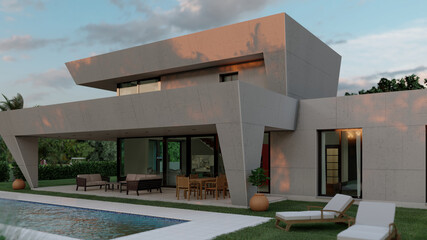A well-designed home is more than just a place to live—it reflects lifestyle, functionality, and personal taste. From modern minimalism to classic charm, house designs influence how spaces are used, how natural light flows, and how families interact daily. Understanding the elements of thoughtful house design can help homeowners create spaces that are both practical and aesthetically pleasing.

The Importance of House Designs
House design combines architecture, interior layout, and exterior aesthetics to create harmonious living spaces. Thoughtful designs maximize comfort, energy efficiency, and usability. They also improve property value and enhance the overall quality of life.
Functional house designs consider flow between rooms, natural lighting, ventilation, and storage solutions. A well-designed home allows residents to move seamlessly between spaces, reduces clutter, and supports daily routines. Additionally, aesthetically pleasing designs create an inviting atmosphere, blending beauty with practicality.
Popular House Design Styles
Numerous house design styles cater to different tastes and needs. Some of the most popular include:
Modern Design
Modern house designs emphasize clean lines, open spaces, and minimalistic aesthetics. Large windows, flat roofs, and neutral color palettes create a sleek, contemporary look. Modern designs often integrate indoor and outdoor spaces to enhance natural light and connection with the environment.
Contemporary Design
Contemporary homes focus on the current architectural trends, often blending elements from various styles. Flexibility, innovative materials, and creative layouts characterize contemporary designs, making them adaptable to changing family needs.
Traditional Design
Traditional house designs feature classic elements such as pitched roofs, symmetrical layouts, and decorative moldings. This style emphasizes warmth, coziness, and timeless appeal. Traditional homes often incorporate natural materials and rich color palettes.
Minimalist Design
Minimalist designs prioritize simplicity, functionality, and uncluttered spaces. Neutral tones, open layouts, and carefully chosen furnishings create a calm, serene environment. Minimalism is ideal for those seeking a modern yet practical living space.
Luxury Design
Luxury house designs combine elegance, advanced technology, and high-quality materials. Expansive floor plans, premium finishes, and unique architectural features create a sense of sophistication and comfort. Luxury homes often include custom amenities such as home theaters, gyms, and outdoor living spaces.
Key Elements of Thoughtful House Designs
Effective house designs consider both functionality and aesthetics. Some critical elements include:
- Open Floor Plans – Encourages flow between living, dining, and kitchen areas, promoting connectivity and spaciousness.
- Natural Lighting – Large windows, skylights, and light-reflective surfaces enhance brightness and reduce energy use.
- Storage Solutions – Built-in cabinets, closets, and multipurpose furniture prevent clutter and optimize space.
- Outdoor Integration – Balconies, patios, and gardens connect indoor and outdoor living for a harmonious environment.
- Energy Efficiency – Proper insulation, efficient windows, and sustainable materials reduce energy costs and environmental impact.
- Room Functionality – Each space is designed for its purpose, from home offices to entertainment areas, ensuring practical use.
Incorporating these elements ensures that homes are not only beautiful but also functional for daily life.
Benefits of Well-Designed Homes
Investing in thoughtful house designs provides several advantages:
- Enhanced Comfort – A well-planned layout supports everyday living and personal comfort.
- Increased Property Value – Attractive, functional designs appeal to buyers and improve market value.
- Better Energy Efficiency – Optimized designs reduce heating, cooling, and lighting costs.
- Improved Aesthetics – Harmonious design elements create a visually pleasing environment.
- Adaptability – Flexible layouts can accommodate future changes, such as growing families or evolving lifestyles.
These benefits make house design a critical factor in both immediate enjoyment and long-term investment.
Tips for Choosing the Right House Design
Selecting the right design involves careful consideration of lifestyle, needs, and personal preferences:
- Assess Your Needs – Consider family size, work-from-home requirements, and daily routines.
- Determine Budget – Balance desired features with available funds to ensure affordability.
- Consider Site and Location – Natural light, views, and climate impact the design and orientation of the home.
- Think About Future Needs – Plan for potential expansions or changes in family structure.
- Incorporate Personal Style – Choose colors, materials, and finishes that reflect individual taste.
- Consult Professionals – Architects and designers provide guidance, ensuring structural integrity and aesthetic appeal.
Proper planning ensures a home that meets practical needs while remaining visually striking.
Modern Trends in House Designs
Current trends in house design reflect changing lifestyles and technological advancements:
- Sustainable Materials – Eco-friendly construction materials reduce environmental impact.
- Smart Homes – Integration of smart lighting, security, and appliances enhances convenience and efficiency.
- Multipurpose Rooms – Flexible spaces accommodate home offices, gyms, and entertainment areas.
- Indoor-Outdoor Living – Seamless transitions between interior spaces and outdoor areas are increasingly popular.
- Minimalist and Open Layouts – Clean, uncluttered spaces emphasize simplicity and comfort.
Staying informed about design trends allows homeowners to create spaces that are both contemporary and timeless.
House designs play a crucial role in shaping the way we live, work, and interact in our homes. From functional layouts to stylish aesthetics, a well-designed home enhances comfort, energy efficiency, and property value. By considering personal needs, lifestyle, and design trends, homeowners can create spaces that are practical, beautiful, and adaptable for the future.
Whether embracing modern minimalism, traditional charm, or luxurious sophistication, thoughtful house designs inspire creativity, well-being, and long-lasting satisfaction. Investing in professional guidance and careful planning ensures a home that not only looks stunning but also supports a comfortable, organized, and fulfilling lifestyle.